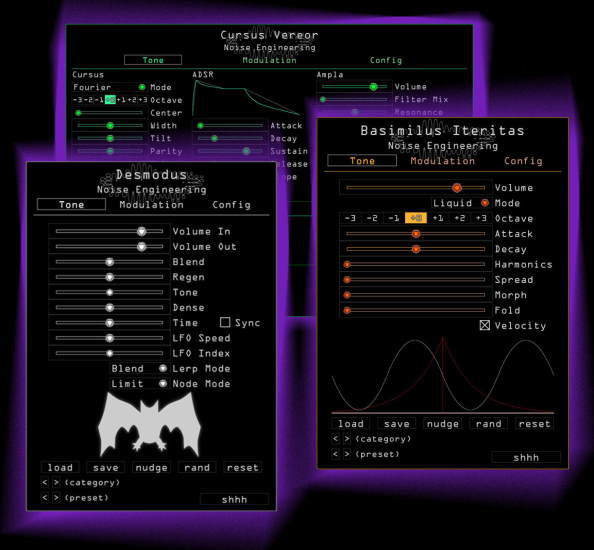Noise Engineering Basimilus, Cursus and Desmodus

Noise Engineering, long known for their distinctive Eurorack modular synthesizers, brings three of their most popular models to the plugin format. Known for the unique sounds and textures their modules create, Noise Engineering has become a fan favorite for modular synth users from artists, producers, DJs, and sound designers worldwide such as Martin Gore of Depeche Mode, producer/musician/songwriter Rik Simpson, filmmaker JJ Abrams, composer/producer Tori Letzler aka TINYKVT, producer/musician EdIT of the Glitch Mob, and so many more.
Stephen McCaul and Kris Kaiser, husband-and-wife co-founders of Noise Engineering, have had plugin versions of some of their products in the works for several years. According to Kris, “We speak to so many customers who love the modules, but need either the portability or the fast recall functionality of plugins.” Added Stephen, “Because many of our products are digital, porting the products into plugins was straightforward: it means the same core synthesis, without the space constraints we run into in hardware.” The team spent a few years optimizing the plugins, the modulation structures, and the installation, developing everything in-house. Along the way, they discovered the joy that came with software versions: more flexibility and power meant that extra parameters could be exposed. And of course multiple instantiations cost nothing. “We always tell the story about a set Stephen did with 11 Basimilus Iteritas modules. That’s obviously been out of reach for almost anyone...until now,” said Kris.
Last year, they tested the waters with a free bundle of three plugins. “We learned a lot from the experience of releasing the Freequel bundle, and it all helped make these plugins even better. We are so excited to launch Bundle 1!” said Markus Cancilla, whose title is Chief of Destruction.
Bundle 1 includes three plugins:
- Cursus Vereor — A spectral synthesizer designed for intuitive control over unique tones.
- Basimilus Iteritas — A percussion synthesizer (and more) that’ll knock your socks off
- Desmodus — A synthetic tail-generator reverb and atmospheric creation tool.
Because these plugins come from their hardware predecessors, they are designed first and foremost with playability and expression in mind. Each plugin has four powerful and versatile LFOs: choose between wave, step, and envelope LFOs to modulate your sound. Adjustable randomization and noise make it easy to add a little variation to your patches. All parameters, including the four Macros, can respond to MIDI velocity and aftertouch. User-friendly MIDI learn and complex mappings like polyphonic aftertouch make them even more fun.
The team confirms more development, and more plugins, are in the works, too. MPE support, tooltips, language localization, and more are in the current development pipeline. Look for more from Noise Engineering soon
Initially launched in AAX only, plugins now offer major feature updates for early adopters as well licenses for AU and VST3. To update, anyone with a current AAX license can simply return to the Noise Engineering Customer Portal to download the most recent installer from the Plugins tab and run it. Backward compatibility is maintained, you’ll just have more features.
Notable features
- AAX, AU, VST3
- 64-bit Intel + M1
- Mac and Windows
- Based on the popular Eurorack modules
- Innovative sounds unlike anything on the market
- Intuitive interfaces to easily and quickly manipulate sound
- Use the Random button to generate new patches in one click
- Easy to automate, user-friendly controls
- MIDI learn and complex MIDI mapping, including velocity and polyphonic aftertouch
- Tons of presets included
Basimilus Iteritas is a parameterized digital drum synthesizer with its roots in the analog world. At its heart, it is a simple six-oscillator additive/FM synthesizer with adjustable waveforms, harmonic spread, and envelope timing, with noise oscillator added in for added percussive variety. Sounds can be fed into Noise Engineering’s signature wavefolder for crunch and variety. Add to that a powerful modulation system and extensive MIDI control, and you have a synth that you’ll want to use on every track.
Cursus Vereor is a synthesizer that produces unique timbres from spectral controls. It features three synthesis modes based on different concepts of frequency: Fourier, which uses sine waves; Daubechies, using wavelets; and Walsh mode, using square waves. It has a musical tone structure and can produce an extremely wide variety of harmonic sounds. Plus, with its powerful modulation system, you’re in for a world of new sounds.
Desmodus is Noise Engineering’s take on a reverb. This is a true stereo in/stereo out effect. Less of a room simulator and more of a synthetic tail generator with features designed for sound design and performance, the parameters on Desmodus allow you to take the effect from a delay to a beautiful reverb to an uncanny, nightmarish atmosphere with the change of a few parameters. Desmodus also includes Electus, an alternate version that allows tempo sync. Desmodus isn’t a reverb: it’s an instrument on its own that’s designed to be played. Throw a little modulation at it, and it’ll go beyond any effect you’ve heard before.
 How to resolve AdBlock issue?
How to resolve AdBlock issue?